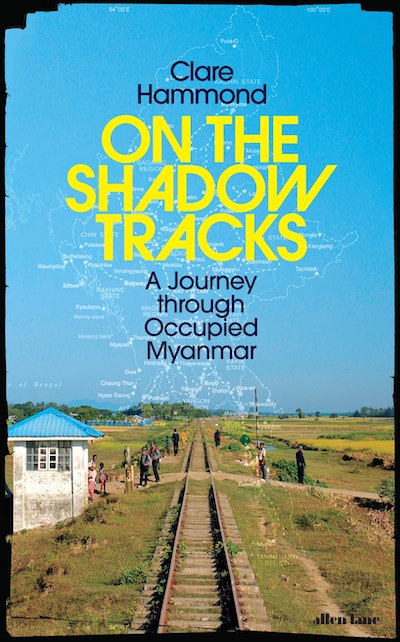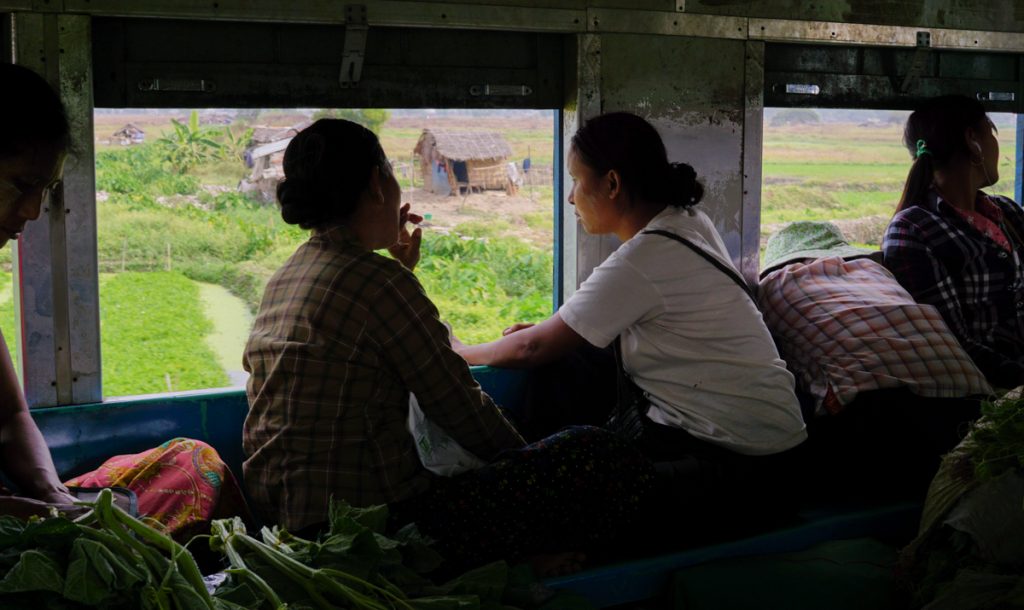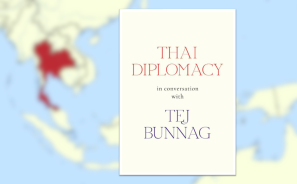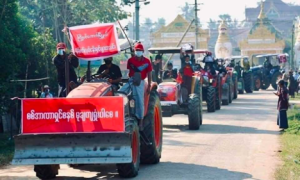
Under review: Clare Hammond’s “On the Shadow Tracks: a Journey through Occupied Myanmar” published by Allen Lane.
“The second Death Railway”: that is how an activist in Dawei in Myanmar’s deep south had described it. No one knows how many forced labourers had died in building it, just as the world doesn’t know the number of—or even remember—the Burmese and other Asian slave labourers who died building the first Death Railway when the Japanese Army attempted to link Burma and Thailand by rail during WWII.
Those conscripted workers who had been forced to work alongside the Allied prisoners of war were known colloquially as the “sweat army”; as children we had listened to horror stories about that time. In a disturbing case of collective amnesia, there has been no postwar accounting nor restitution, especially after Japan became a top bilateral donor.
In 1989 I accompanied a foreign journalist to Taunggyi, and one of the Shan notables we met had used the same term to describe the Myanmar army’s use of local porters, men and women. This is a decades-old practice and although there are several human rights reports over the years, there is yet no full account of the abuses suffered.
Beginning the early 1990s the then-military junta decreed that entirely new railroads were to be built across the country. (There was even one that was laid out on the streets of the old royal capital of Mandalay, but fortunately dismantled now).
It was the daunting task of travelling on and writing about all those rail-lines that author Clare Hammond took upon herself. I haven’t heard of any woman traveller, much less a writer, who has done that. I myself was a train buff in my early years and have travelled extensively on trains in India, China, Thailand and I might add, Australia. But if you ask me, I would never travel upon the lines that Hammond took such pains to traverse.
Just one aspect is that she (or anyone for that matter) has to contend with the countless denizens of Myanmar officialdom—policemen, railway staff, managers and ex-government ministers, all too ready to ask her endless questions and then stonewall when they are asked something. This doesn’t exclude ethnic rebel staff who are defensive about their own turf. But with her reserves of patience, forbearance and persistence, Hammond either got what she wanted or showed up her “host” for what they were trying to hide. Those long-ingrained traits in regime appendages will take a long time to cast off.
She travelled to all the states and regions of Myanmar, except mountainous Chin state, which does not have railroads at all. In each chapter and region she weaves in the contentious and unresolved issues of the country, like land in Magway and the Rohingya in Rakhine, and so on. She says of her primary motive:
As a journalist, it was the absence of information, more than anything, that got me hooked on the story. In the world I inhabited and thought I knew, the idea that thousands of miles of railway could be built without any national attention or scrutiny was unimaginable. (p24)
In Magway, arable land had been confiscated for rail lines, leaving farming families destitute. Those railways were never operational and have been abandoned now. From Sittway, the capital of Rakhine, there is a short line on which a diesel railcar runs to the Rohingya relocation camps. The carriages are segregated into Muslim and Rakhine parts.
Over time the author, who lived for six years in Myanmar, dredged up deep insights into what makes Myanmar authoritarianism tick. If one reads closely enough, one can see why reforms failed and why the quasi-democratic government of the NLD (2016–2020) did not live up to peoples’ expectations. One could also detect premonitions of the attempted coup in 2021 and its present bloody consequences.
Perhaps the most profound of her insights came after seeing the munitions factories on the west bank of the Ayeyarwady in Magway Region:
Was it possible, I wondered, that the military’s railways—all of its railways—were weapons in themselves? Everything I’d heard on my journey so far indicated that they weren’t built for economic development, as railways usually were, but instead to increase the military’s power, through the state. The use of mass forced labour on the railways had helped the generals to break multiple insurgencies. Building railways also required a large military presence, which subsequently become permanent, helping the military to wield power in the far reaches of Myanmar. In areas that were already under military control, contracts for new railways had enriched officials and their cronies, engendering loyalty. And all over the country, new military bases and factories were connected to the railway network, making it easier (at least, on the lines that still functioned) for soldiers and weapons to be deployed against Myanmar’s people. (p106)
The Kachin Independence Organization had levelled similar accusations that the proliferation of battalion bases in Kachin areas were designed to be military footholds, as well as permanent incursions into non-Buddhist areas. That it said, was the real reason the ceasefire broke down in 2011.
At about the same time that railroads were being laid, there was also a trans-river bridge building spree that complemented the rail lines, and the laying out of bypass roads around each sizeable town—always with security in mind. The dictator would decree that a road and rail bridge would be built here—at Pakokku, over the Ayeyarwady River for instance—and the subordinate generals, who were also ministers, jumped to it. Cost-benefit and utilisation studies were unnecessary for such projects that were solely aimed at benefiting the people.
On a parallel but larger scale, this was played out in the armed forces, a fact that reinforces Hammond’s insights on railroads. In the 1990s large new military units emerged, but they were never publicly identified. They were only known by their acronyms and numbers.
Review: “Thai Diplomacy”
Edited interviews with Tej Bunnag provide "unvarnished insights" and "nuanced history" for students of Thai foreign policy.
It was much later that I came to know that the formations were actually infantry divisions, but called “operations commands”. There were around 20 of them, stationed all over the country. At that time there were state-owned newspapers and privately-run weeklies, but they hardly published on military matters, and the result was that the public could not know. The launching of military frigates and acquisition of jet aircraft were sometimes shown, but only cursorily. A massive military buildup was going on continuously, unbeknownst to the people.
But the Achilles’ heel of this grandiose yet devious plan lay in manpower: recruitment and retention. The junta chief and his generals had totally and fatally miscalculated. I half-jokingly tell friends that at the prison I was in, half the inmates were junkies and the other half were army deserters. And the final result is the abysmal performance of the military in the current civil war. An infantry battalion of 700 was down to 150–200 even before the present fighting began. Poor enlistment and high desertion rates persist to this day.
••••••••••••
Hammond is unsparing of the colonial rule and record of her own country Britain. On her travels in central Shan state—undercover this time—she came across an area from which 400,000 people had been uprooted in a vast clearing operation, with attendant killings and other atrocities. The rest of the country hardly knew about this. She compared it what British Commissioner Charles Crosthwaite had ordered in the “Pacification” of Burma in 1887–90.
In another vein, she had attended glamorous events in Naypyidaw in the heyday of the investor “gold rush”:
There was a lot of talk about responsible business, and there were new aid programmes, but all of this was to some degree a distraction from the main event, which was a rush for profits that was driven by many of the same forces that had once driven British colonial expansion. There was a need, not just in Britain but around the world, for new sources of cheap raw materials and labour, new investments to improve returns, and new markets for manufactured products—all to fuel growth that would fend off unemployment and unrest at home. (p298)
Yes, Myanmar was haunted by the empire, with its ideas about race and the armed conflicts it had set in motion, and its rapacious, extractive logic. But wasn’t Britain also haunted by its colonial past? (p215)
What is happening in Myanmar now is very fundamental, almost a return to pre-modern times, and is playing out like an ancient fable. In the fatal disputation between two rulers, one brutal but inept, and the other popular but equally incapable, the people are having to take things into their own hands. Indeed it was forced upon them, and they have risen to the occasion. These kinds of uprisings tend to be protracted and bloody. But the motivation has a deep rootedness in society and community, which goes beyond merely obeying a leader or is in line with an ideology.
But as the international community fails them, people across Myanmar continue to fight. Nothing about their struggle is easy: Myanmar is a traumatized society and it is once again permeated by fear … But while the military deals in terror, the resistance is fuelled by hope. At its core, this is a struggle for basic liberties against institutionalized violence and greed, and it is a struggle that the people of Myanmar are determined to win. (p317)
In the pipeline are new high-speed rail and expressway projects from the Chinese border to Kyaukphyu in Rakhine, on the Bay of Bengal. Agreements have been signed, and the Chinese are anxious to move ahead with construction despite the armed conflict. When that high-speed rail comes, it will signal, amongst other things, the end of 150 years of railways as we have known it.
Hammond writes evocatively about the trains she rode and the people she met. The slow wet rides in the Delta during the monsoon and places she ended up that had no lodgings whatsoever. The Bawdwin mines of Empire days which were once “a little part of England”. The pagodas of Kakku in the PaO region in the half-light. She has a feel for the local people and most of the (non-official) people she met warmed to her. This is a book with a whole lot of heart for Myanmar and her people.
 Facebook
Facebook  Twitter
Twitter  Soundcloud
Soundcloud  Youtube
Youtube  Rss
Rss 



